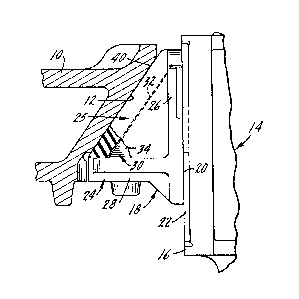Une partie des informations de ce site Web a été fournie par des sources externes. Le gouvernement du Canada n'assume aucune responsabilité concernant la précision, l'actualité ou la fiabilité des informations fournies par les sources externes. Les utilisateurs qui désirent employer cette information devraient consulter directement la source des informations. Le contenu fourni par les sources externes n'est pas assujetti aux exigences sur les langues officielles, la protection des renseignements personnels et l'accessibilité.
L'apparition de différences dans le texte et l'image des Revendications et de l'Abrégé dépend du moment auquel le document est publié. Les textes des Revendications et de l'Abrégé sont affichés :
| (12) Brevet: | (11) CA 1305361 |
|---|---|
| (21) Numéro de la demande: | 1305361 |
| (54) Titre français: | PATIN STABILISATEUR A REVETEMENT POLYMERE |
| (54) Titre anglais: | FRICTION CASTING WITH POLYMER COVER |
| Statut: | Durée expirée - après l'octroi |
| (51) Classification internationale des brevets (CIB): |
|
|---|---|
| (72) Inventeurs : |
|
| (73) Titulaires : |
|
| (71) Demandeurs : |
|
| (74) Agent: | RICHES, MCKENZIE & HERBERT LLP |
| (74) Co-agent: | |
| (45) Délivré: | 1992-07-21 |
| (22) Date de dépôt: | 1989-05-03 |
| Licence disponible: | S.O. |
| Cédé au domaine public: | S.O. |
| (25) Langue des documents déposés: | Anglais |
| Traité de coopération en matière de brevets (PCT): | Non |
|---|
| (30) Données de priorité de la demande: | ||||||
|---|---|---|---|---|---|---|
|
FRICTION CASTING WITH POLYMER COVER
Abstract of the Disclosure
A friction wedge for use in a railroad car truck
bolster pocket which has a slanted rear wall and adjoining side
walls perpendicular thereto, one surface thereof adapted to bear
against a portion of a car truck side frame and a slanted surface
and adjoining sides adapted to bear against the slanted rear wall
and adjoining side walls of the bolster pocket. The friction
wedge includes a metal body and a polymer cover providing the
slanted surface and adjoining sides, with the polymer cover being
formed in a plurality of sections movable relative to each other
and the metal body such that, during use, the polymer sections
may move into contact with the pocket rear wall and adjoining
side walls.
Note : Les revendications sont présentées dans la langue officielle dans laquelle elles ont été soumises.
Note : Les descriptions sont présentées dans la langue officielle dans laquelle elles ont été soumises.

2024-08-01 : Dans le cadre de la transition vers les Brevets de nouvelle génération (BNG), la base de données sur les brevets canadiens (BDBC) contient désormais un Historique d'événement plus détaillé, qui reproduit le Journal des événements de notre nouvelle solution interne.
Veuillez noter que les événements débutant par « Inactive : » se réfèrent à des événements qui ne sont plus utilisés dans notre nouvelle solution interne.
Pour une meilleure compréhension de l'état de la demande ou brevet qui figure sur cette page, la rubrique Mise en garde , et les descriptions de Brevet , Historique d'événement , Taxes périodiques et Historique des paiements devraient être consultées.
| Description | Date |
|---|---|
| Inactive : Périmé (brevet sous l'ancienne loi) date de péremption possible la plus tardive | 2009-07-21 |
| Inactive : CIB de MCD | 2006-03-11 |
| Inactive : CIB de MCD | 2006-03-11 |
| Inactive : Grandeur de l'entité changée | 1998-06-25 |
| Accordé par délivrance | 1992-07-21 |
Il n'y a pas d'historique d'abandonnement
| Type de taxes | Anniversaire | Échéance | Date payée |
|---|---|---|---|
| Annulation de la péremption réputée | 1997-07-21 | 1997-06-27 | |
| TM (catégorie 1, 5e anniv.) - petite | 1997-07-21 | 1997-06-27 | |
| TM (catégorie 1, 6e anniv.) - générale | 1998-07-21 | 1998-06-15 | |
| TM (catégorie 1, 7e anniv.) - générale | 1999-07-21 | 1999-06-11 | |
| TM (catégorie 1, 8e anniv.) - générale | 2000-07-21 | 2000-07-07 | |
| TM (catégorie 1, 9e anniv.) - générale | 2001-07-23 | 2001-06-13 | |
| TM (catégorie 1, 10e anniv.) - générale | 2002-07-22 | 2002-06-27 | |
| TM (catégorie 1, 11e anniv.) - générale | 2003-07-21 | 2003-06-09 | |
| TM (catégorie 1, 12e anniv.) - générale | 2004-07-21 | 2004-06-16 | |
| TM (catégorie 1, 13e anniv.) - générale | 2005-07-21 | 2005-06-07 | |
| TM (catégorie 1, 14e anniv.) - générale | 2006-07-21 | 2006-06-07 | |
| TM (catégorie 1, 15e anniv.) - générale | 2007-07-23 | 2007-07-03 | |
| TM (catégorie 1, 16e anniv.) - générale | 2008-07-21 | 2008-06-30 |
Les titulaires actuels et antérieures au dossier sont affichés en ordre alphabétique.
| Titulaires actuels au dossier |
|---|
| STANDARD CAR TRUCK COMPANY |
| Titulaires antérieures au dossier |
|---|
| WILLIAM C. EUNGARD |